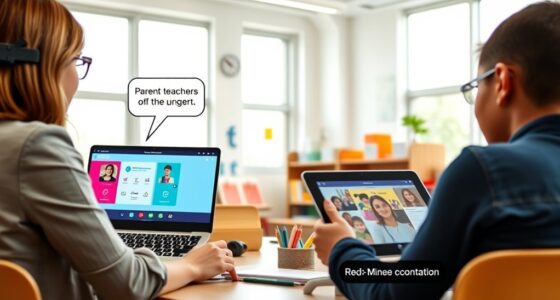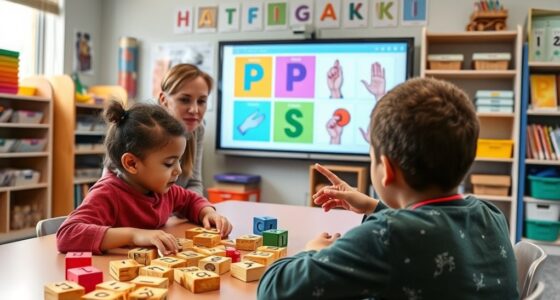Advocates are actively fighting language deprivation by pushing for policies that guarantee deaf children access to early sign language education and essential resources. They highlight the importance of early intervention, technology, and trained educators to support language development. Addressing barriers like resource gaps and geographic disparities is essential to guarantee equitable learning opportunities. If you want to understand how communities and policies are making a difference, keep exploring these critical efforts.
Key Takeaways
- Advocates emphasize early sign language exposure to prevent language deprivation in deaf children.
- Policy efforts aim to secure equitable access to specialized resources and qualified educators.
- Campaigns promote bilingual education, integrating sign and spoken language for comprehensive development.
- Addressing geographic and resource barriers is critical to ensuring all deaf children receive quality education.
- Increased funding and technological support are essential to uphold deaf children’s educational rights.
The Impact of Language Deprivation on Deaf Children

When deaf children do not have access to a fully developed language early in life, it can severely hinder their cognitive, social, and emotional development. Without early language exposure, their auditory processing skills can suffer, making it harder to interpret sounds and develop effective communication. This often leads to a significant language delay, affecting vocabulary, grammar, and overall understanding. As a result, these children may struggle with social interactions, feeling isolated or misunderstood. The lack of early language access limits their ability to think critically and learn effectively, impacting academic achievement and emotional well-being. Addressing this deprivation early is vital to support healthy development and prevent lifelong disadvantages caused by delayed language acquisition. Ensuring access to early intervention services can help support the dissemination of information and resources about early intervention and advocacy efforts. Research shows that early language exposure plays a critical role in shaping neural pathways essential for communication skills, and providing appropriate communication methods can significantly improve outcomes for deaf children. Additionally, promoting awareness about language deprivation emphasizes the importance of timely support and intervention.
The Role of Sign Language in Early Education

Introducing sign language early helps you connect with deaf children and supports their overall growth. When they learn sign language from the start, their cognitive skills improve, and they gain confidence in communicating. This early exposure empowers them to participate fully in their education and social life. Utilizing predictive modeling in educational data mining as a tool can also help identify the most effective teaching methods for individual learners. Additionally, ensuring appliance safety through proper testing and compatibility measures can help create a safer environment for their daily activities.
Early Sign Language Acquisition
Early sign language acquisition plays an essential role in shaping the foundation of effective deaf education. When children learn sign language early, their gesture development accelerates, helping them communicate more naturally. Parental involvement is key—you can support your child’s language growth by actively engaging in sign language use at home. This consistent exposure fosters a strong language environment and boosts confidence. Early signing also helps your child connect with others and builds social skills from a young age. The more you incorporate sign language into daily routines, the more seamless their language development becomes. Research shows that early language exposure significantly impacts cognitive and social development. By prioritizing early sign language learning, you set your child up for better educational opportunities and a richer, more expressive way to communicate.
Enhancing Cognitive Development
Sign language plays a crucial role in enhancing cognitive development in young children, especially those who are deaf or hard of hearing. Using sign supports bilingual benefits, allowing children to develop linguistic skills in both sign language and spoken language. This approach strengthens neural pathways and promotes problem-solving abilities. To maximize these benefits, focus on:
- Encouraging early exposure to sign language to boost brain development.
- Supporting bilingual education to improve communication skills.
- Recognizing the importance of cultural identity linked to sign language use.
- Promoting social interactions that reinforce cognitive growth.
Building Communicative Confidence
Building communicative confidence is essential for young children learning through sign language, as it empowers them to express their needs and ideas effectively. Visual storytelling plays a key role, helping children connect emotions and concepts with signs, boosting their understanding and self-assurance. Peer mentorship encourages social interaction, allowing children to practice signing in a supportive environment, which strengthens their confidence. When children see their peers using sign language successfully, they become more willing to participate and share. This sense of belonging and accomplishment fuels their desire to communicate and grow. By fostering these strategies, you help children build a strong foundation of trust in their own abilities, making sign language a natural, confident part of their everyday lives. Additionally, incorporating visual storytelling techniques enhances comprehension and retention, making the learning process more engaging and effective. Recognizing the importance of early intervention can also significantly influence long-term communication success for deaf children. A focus on foundation skills ensures children develop the necessary tools to become confident communicators from an early age. Moreover, understanding the value of environmental considerations helps create a supportive atmosphere for learning and growth. Furthermore, integrating comprehensive educational programs can address diverse learning needs and foster inclusive development.
Barriers to Access and Educational Resources

You may find that limited resources and educational materials make it hard to get the support you need. Geographical gaps can prevent access to quality deaf education, especially in rural areas. Without enough resources and accessible options, your ability to learn and communicate effectively gets further restricted. Additionally, the lack of specialized educational resources tailored to deaf children exacerbates these barriers, making it even more challenging to achieve equitable learning opportunities. As advances in educational technology like Intelligent Tutoring Systems develop, ensuring equitable access remains a critical challenge for deaf education. Incorporating advanced fraud detection techniques such as predictive analytics and geolocation data can help identify and address systemic barriers affecting students’ access to resources. Ensuring the availability of appropriate tools can significantly improve learning experiences for deaf students. Addressing these issues is essential to promote healthy learning environments where all students can thrive.
Limited Resource Availability
Have you ever wondered how limited resources hinder access to quality deaf education and language development? Funding shortages and technology gaps are major obstacles. Without proper funding, schools can’t afford essential tools or trained staff. Technology gaps mean many deaf children lack access to hearing aids, cochlear implants, or sign language learning software. This limits their ability to communicate and develop language skills. To understand the impact, consider:
- Insufficient funding reduces availability of specialized programs.
- Lack of updated technology hampers effective teaching.
- Fewer trained educators mean lower-quality instruction.
- Limited resources restrict early intervention services.
- Resource allocation plays a critical role in managing resources and ensuring compliance with regulations. Moreover, a lack of auditory processing support can further impede language acquisition in deaf children. During the COVID-19 pandemic, disruptions highlighted the importance of cybersecurity vulnerabilities and the need for resilient digital infrastructures in education. Understanding the technology gaps involved reveals how many deaf children lack access to essential tools, further hindering their development. These barriers prevent many deaf children from receiving the education they deserve, deepening language deprivation and widening educational gaps. Addressing resource limitations is critical to ensuring equal opportunities for all deaf students.
Geographical Access Gaps
Limited resources within schools are only part of the challenge; where you live greatly affects your access to quality deaf education. Rural areas often lack specialized programs, making outreach efforts crucial. Without proper rural outreach, students in remote communities miss out on essential services and support. Transportation barriers further exacerbate the problem, forcing many to travel long distances just to attend a school with appropriate resources. These hurdles delay or prevent access to consistent instruction and language development. Without reliable transportation or nearby facilities, deaf children face significant obstacles in receiving early intervention and ongoing education. Geographic disparities also impact the availability of dedicated services, which are vital for effective language acquisition. Additionally, the lack of access to appropriate resources in remote areas can hinder the development of crucial communication skills. The absence of comprehensive safety measures can also increase risks for students in these settings. As a result, geographical gaps create unequal opportunities, reinforcing disparities in deaf education based on location. Overcoming these barriers requires targeted outreach and improved transportation options to ensure all students can access the education they deserve.
Insufficient Educational Materials
Insufficient educational materials substantially hinder access to quality deaf education. Limited resources affect everything from textbooks to sign language tools, making it harder for you to learn effectively. This issue often stems from uneven resource distribution and inadequate educational funding. Without proper materials, students miss out on essential language exposure and academic support. To address this, focus on:
- Increasing educational funding dedicated to deaf education.
- Ensuring equitable resource distribution across schools and regions.
- Providing up-to-date sign language dictionaries and multimedia tools.
- Developing accessible curricula tailored to deaf students’ needs.
Policy Initiatives Advocates Are Promoting

Advocates are actively promoting policy initiatives that prioritize the rights of deaf individuals to access quality education and language acquisition. They focus on shaping language policy to guarantee that sign language is recognized as a legitimate and essential part of deaf education. Through advocacy campaigns, they push for laws that guarantee early language exposure and equitable resources. These initiatives aim to eliminate barriers that hinder deaf children’s access to effective communication methods. By engaging policymakers, educators, and communities, advocates seek to establish standards that protect deaf students’ rights to bilingual education and accessible learning environments. Their efforts are vital in transforming outdated policies and fostering a system that respects and supports linguistic diversity for deaf individuals.
Success Stories and Ongoing Challenges

While there have been notable successes in advancing deaf education, ongoing challenges continue to hinder full realization of these gains. Technology innovation has improved access, but gaps remain, especially in rural areas. Family involvement remains vital; when families are engaged, children often achieve better language development. However, many families lack resources or awareness to support their child’s educational needs. To illustrate, consider these points:
- Technology access varies widely, limiting learning opportunities.
- Family engagement levels influence language acquisition success.
- Schools often lack trained personnel to implement innovative methods.
- Policy gaps hinder widespread adoption of best practices.
Despite progress, addressing these challenges requires continued focus on technology and family support to guarantee every deaf child achieves their full potential.
How Communities Can Support Deaf Education Rights

Community support plays an essential role in ensuring deaf children receive quality education and their rights are protected. Your involvement can make a real difference by advocating for accessible learning environments and promoting awareness. Participate in local events, support deaf-led initiatives, and push for inclusive policies. Parental education is also vital; by learning about sign language and deaf culture, you empower families to advocate effectively for their children’s needs. Encourage schools to adopt communication-friendly practices and collaborate with deaf educators to improve resources. When communities unite around these efforts, they create a stronger foundation for deaf children’s rights. Your active engagement helps break down barriers, ensuring every child has equal access to education and the opportunity to thrive.
Frequently Asked Questions
How Do Cultural Attitudes Influence Deaf Education Policies Worldwide?
Cultural perceptions greatly impact deaf education policies worldwide, shaping how societies view sign language and deafness itself. If your culture sees deafness as a disability, policy barriers often limit access to sign language programs and inclusive education. Conversely, cultures that value deaf identity promote policies supporting sign language, bilingual education, and cultural pride. Your attitudes influence whether deaf children receive equitable, respectful educational opportunities or face exclusion and marginalization.
What Are the Long-Term Societal Benefits of Early Sign Language Exposure?
Imagine planting a seed that blossoms into lifelong benefits. Early sign language exposure boosts your child’s cognitive development, sharpening their thinking skills and problem-solving abilities. It also fosters social integration, helping them connect confidently within diverse communities. By embracing early sign language, you’re not just supporting individual growth but nurturing a more inclusive society where deaf and hearing people thrive together. The long-term rewards are truly transformative.
How Can Technology Improve Access to Deaf Education in Underserved Areas?
You can enhance access to deaf education in underserved areas by leveraging technology like remote learning platforms and mobile applications. These tools allow you to connect with qualified teachers and resources regardless of location. Mobile apps can provide sign language tutorials and real-time translation, making learning more accessible. Remote learning ensures that even children in remote or underserved communities receive quality education, helping bridge the gap and promote inclusivity for deaf students.
What Role Do Parents Play in Advocating for Their Deaf Children’s Language Rights?
Your role as a parent is absolutely vital—you hold the power to change your deaf child’s future. Through parent advocacy and active family involvement, you can secure access to sign language education and essential resources. Your voice can challenge barriers and push for better policies, making certain your child’s language rights are protected. Never underestimate how your passionate support can transform their opportunities and guarantee they thrive in a world that values their communication needs.
Are There Differences in Deaf Education Rights Across Different Countries or Regions?
You’ll find that deaf education rights vary across countries and regions, especially regarding sign language policies. Some areas prioritize inclusive education and recognize sign language as a legal right, reducing educational disparities. Others lack clear policies, leading to limited access and disparities in quality. These differences influence how deaf children learn and communicate, underscoring the need for global advocacy to guarantee equitable education opportunities for all deaf students.
Conclusion
Imagine a world where every deaf child’s voice blossoms like a vibrant garden, rooted in the strength of sign language. By supporting policies and resources, you help open doors that let their potential shine brightly. Together, we can clear the path through barriers, ensuring their education is a steady stream rather than a silent shadow. Your involvement turns hope into action, creating a future where every child’s voice is heard and celebrated.











